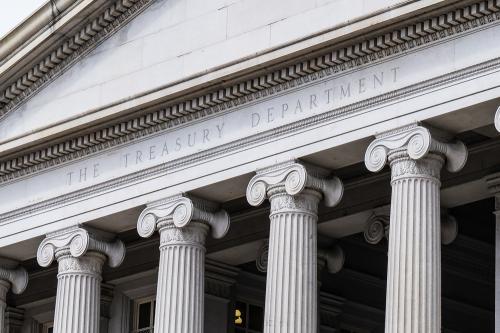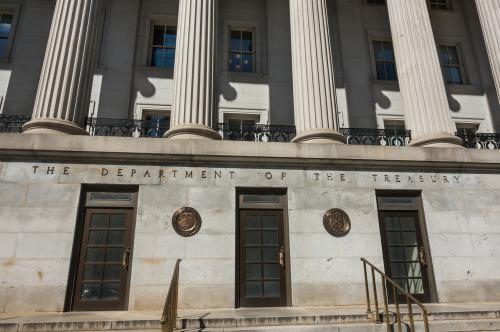There is a legal maximum on how much debt the federal government can accumulate—often called the “debt ceiling” or the “debt limit.” According to Treasury Secretary Janet Yellen, the government will hit the current limit in a few days. Using a variety of accounting tricks (like temporarily diverting government pension funds), the government can postpone the day when it cannot pay its bills but only for a few months. Congress and the administration therefore face the following questions: whether to raise the debt limit, by how much, and what, if any, conditions to attach.
Citizens and the media misunderstand the issues surrounding the debt limit. Policymakers often fuel this misunderstanding with misleading statements that distort the debate.
The issue is really quite simple. The debt limit doesn’t cause the debt any more than a thermometer causes a fever. Debt grows when spending exceeds revenues. That’s it.
Congress should abolish the debt limit and replace it with the simple, common- sense rule that automatically authorizes any borrowing necessary to implement any fiscal legislation that affects the federal deficit. This “Gephardt rule” was in place at various times in the past.
Raising the debt limit is not about new spending; it is about paying for previous choices policymakers legislated.
Here are seven things to understand about the debt limit and why it is unnecessary and obstructive.
- The debt limit has been raised continually for more than a century. The first debt limit was established in 1917 to make it easier to finance mobilization efforts in World War I. Before that, Congress generally had to authorize each bond issue. The limit has been raised 78 times since 1960, including 20 times since 2001. Congress usually raises (or suspends) the debt limit before it is reached. Along the way, the party out of power demagogues the debt limit, blaming the other party for its profligacy.
- Raising the debt limit is not about new spending; it is about paying for previous choices policymakers legislated. Voters often incorrectly assume—and lawmakers often incorrectly assert—that a vote to raise the debt ceiling is a vote for more red ink. In fact, raising the debt limit is about paying for past choices. Debt limit debates are about whether Congress should authorize the government to borrow to pay for spending that Congress has already authorized. Oddly enough, when Congress authorizes new spending and new taxes, it does not automatically authorize the borrowing needed to make up any difference. Arguing about increasing the debt limit is like having a person charge vacation expenses to his credit card and then debate whether he should pay the credit card company when the bill comes due.
- The uselessness of a debt limit is exhibited by the fact that only one other advanced country—Denmark—has a separate debt limit rule like ours. And they don’t use it as a political football.
- The limit (inappropriately) applies to gross federal debt. The debt limit applies to gross debt: the sum of net debt plus intragovernmental loans. Net debt is what the government owes the public—including investors, pension funds, and domestic or foreign central banks. It is the measure that economists consider to be important. Intragovernmental debt is what one part of the government owes another part. Because it is akin to your right pocket owing your left pocket money, intragovernmental debt is irrelevant to the nation’s fiscal health. Thus, gross debt is a legal concept with little economic significance. Sadly, the popular discussion—even among many so-called experts—sometimes focuses on gross debt, because the bigger number is more eye-catching (although net debt, at around $24.5 trillion, is still pretty big). At the beginning of 2023, about $6.8 trillion (approximately 22% of debt subject to the limit is intragovernmental debt.
- If debt hits the ceiling, the Treasury Department uses several accounting gimmicks to postpone the day of reckoning, but these typically last only a few months. At that point, the government would have to default on interest payments or other obligations—for example, military pay, Social Security and Medicare, tax refunds, or other safety net payments. The law is unclear about which claims are senior. Nor is it clear who has the right to determine seniority. Legislation could set priorities, but any such prioritization would be tested in court. And even if bondholders were paid, not paying all the claims would constitute default, just with a different name, and incur costs for the government.
- If the debt limit were not raised, the amount of spending cuts or tax increases that would be required would equal $1.5 trillion this year and $14 trillion over the next 10 years. For perspective, these figures are larger than total defense spending over the same periods of time. And if there were a default, interest rates would rise, increasing deficits and requiring even larger tax and spending changes.
- The economic consequences of a large-scale, intentional default are unknown, but predictions range from bad to catastrophic. In 1979, an inadvertent temporary partial debt default occurred because of an administrative error; it raised U.S. borrowing costs by $40 billion (in today’s dollars). This was an accidental default on a small batch of Treasury securities, but it spooked investors enough to raise interest payments significantly. An intentional, large-scale default has never happened because in the past it has been unthinkable. To do so now would be to play with fire and risk the United States’ charmed position as a “risk-free borrower” in global credit markets.
The debt limit debates of recent years raised interest rates. Higher interest rates would make solving the long-term fiscal problem harder, not easier, and have ramifications across many sectors of the economy. Net interest payments are already expected to explode over the next 10 years and beyond. Because government bond rates are used, contractually, to determine other interest rates, other interest rates would rise as well. More generally, Treasuries might never again be considered a safe haven. This could generate a variety of additional issues. Banks might classify Treasury holdings as non-performing assets. Some Money Market Mutual Funds would “break the buck”—i.e., fall in nominal value—which could create havoc (as it did in 2008). Some or all federal entities could lose their AAA borrowing status. In general, the disruption to the cornerstone of modern financial markets could have ramifications for the global economy, just as the financial crisis of 2008 spread to the overall economy. With the economy currently teetering on the brink of recession, it would be foolhardy to risk a new worldwide financial panic now.
Conclusion
A desire to change the course of fiscal policy should be manifested in new Congressional initiatives to change the course of future spending and taxes, not in Congressional refusal to pay bills that have arisen from previous Congressional action.
Congress should abolish the debt limit and reinstate the Gephardt Rule so that when new legislation adds to the federal deficit, Congress automatically approves the borrowing needed to finance the new legislation.
Since we know we are going to have to address the limit anyway, why not do it without creating economic damage?
The Brookings Institution is financed through the support of a diverse array of foundations, corporations, governments, individuals, as well as an endowment. A list of donors can be found in our annual reports published online here. The findings, interpretations, and conclusions in this report are solely those of its author(s) and are not influenced by any donation.
The Brookings Institution is committed to quality, independence, and impact.
We are supported by a diverse array of funders. In line with our values and policies, each Brookings publication represents the sole views of its author(s).





Commentary
7 things to know about the debt limit
January 19, 2023